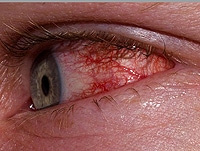Dry Eye Symptom Mystery: Pain Sensitivity a Puzzle Piece?
Systemic pain sensitivity and intolerance may play a role in the poor correlation between dry eye disease symptoms reported by patients and clinical exam findings, according to the results of a large, cross-sectional study between affected and unaffected individuals.
Aiming to solve the mystery surrounding the poor correlation between ocular exam findings and patient-reported symptoms of DED, researchers have suggested severity of tear insufficiency, cell damage, and psychological factors. Now a study of 1635 healthy women enrolled in a population-based UK registry points to higher pain sensitivity and intolerance as possible culprits as well.
“Our results indicate that [a subset of] persons with DED might be more sensitive to pain,” lead study author Jelle Vehof, PhD, from the Department of Ophthalmology and Epidemiology at the University Medical Center Groningen, the Netherlands, toldMedscape Medical News. “Physicians need to keep this in mind when investigating and managing patients with dry eye. Consider the holistic picture, rather than focusing on ocular signs only. Higher pain sensitivity might be as important as ocular signs when explaining dry eye symptoms.”
To test the hypothesis that people with DED have higher pain sensitivity and pain intolerance, the investigators administered the heat pain threshold (HPT) and heat pain suprathreshold (HPST) tests. They placed a probe on the forearm of each woman and slowly increased the heat delivered until participants hit a button to signify pain changed from hot to painful. Tests were repeated on the opposite forearm, and maximal tolerated temperatures were recorded. Both tests started at 32°C but differed in incremental increases in temperature.
Women who reported ocular pain symptoms on the Ocular Surface Disease Index questionnaire were significantly more likely to have high pain sensitivity compared with women who did not report ocular pain symptoms (P = .008 for the HPT and P = .003 for the HPST), Dr. Vehof and associates report in an articlepublished online August 1 in JAMA Ophthalmology.
They also determined that participants with a high pain sensitivity were approximately 75% more likely to report DED pain symptoms compared with those with a low pain sensitivity (31.2% vs 20.5%; odds ratio [OR], 1.76; 95% confidence interval [CI], 1.15 – 2.71; P = .01). The strength of the association increased after correction for older age as a possible confounder (OR, 1.95; 95% CI, 1.24 – 3.06; P = .004).
“We were surprised by the big effect size,” Dr. Vehof said. He noted that individuals with a pain sensitivity higher than the median show DED pain symptoms almost twice as often as those with a lower pain sensitivity.
In terms of clinical significance, Dr. Vehof said, “Finding no ocular signs of dry eye does not mean that the patient does not have any symptoms. Minor ocular surface abnormalities that are not demonstrated by the regular dry eye tests might be sufficient to cause symptoms in patients with high pain sensitivity.”
He added, “We think explaining this to patients is important in the management of dry eye.”
When asked by Medscape Medical News to comment, Ivan R. Schwab, MD, spokesperson for the American Academy of Ophthalmology, said, “It is important to realize that to the patient these symptoms are annoying or even disabling whether they have increased pain sensitivity or not. In other words, the increased pain sensation is part of the disease and still deserves attention.”
The study only supports an association, Dr. Schwab notes, and any cause-and-effect relationship remains unknown. “Perhaps the dryness is related to generalized increased sensitivity that makes the syndrome a systemic disease. We know already that many forms of dry eye are indeed systemic diseases. It is possible that this simply represents another aspect of a larger disease syndrome in some or many cases,” said Dr. Schwab, who is also director of the Cornea and External Disease Service and professor of ophthalmology at the University of California Davis Health System in Sacramento.
Dr. Vehof and associates diagnosed DED based on at least a single “yes” response to these 3 questions: “Have you ever been diagnosed (by a clinician) as having dry eye syndrome?” “Do you currently use artificial tear eye drops or gel?” and “For the past three months or longer, have you had dry eyes (described as a foreign body sensation with itching and burning, sandy feeling, not related to allergy)?” In addition, the investigators tested a consecutive subset of 689 women with the Ocular Surface Disease Index; any score of 15 or greater led to a DED classification.
Information from Industry
See what experts say about the progressive nature of AFib
Drs Calkins, Chung, Ellenbogen, Kowey, Naccarelli, Nattel, and Prystowsky on AFib: pathophysiology, clinical implications, and the importance of sinus rhythm and early treatment.
Get their views
They found no significant differences in the HPT or HPST and the first 2 questions. However, they observed a significantly lower HPST in women who had dry eye symptoms in the last 3 months compared with those who did not (P = .01). Combining all 3 DED questions, persons with DED showed a significantly lower HPT (P= .03) and HPST (P = .003) than those without DED.
The possible mechanism underlying the relationship between dry eye symptoms and heightened pain sensitivity remains unknown, Dr. Vehof said. However, he theorized that the same pain pathways could explain increased sensitivity in both the skin and corneal nerves. “Currently we are investigating how much of the variation in dry eye symptoms is explained by pain sensitivity compared to ocular signs such as tear osmolarity, Schirmer value, and tear break-up time.”
This study was supported by the Wellcome Trust, the Department of Health via the National Institute for Health Research Clinical Research Facility at Guy’s and St. Thomas’ National Health Service Foundation Trust, King’s College London, and Pfizer Pharmaceuticals, which paid for collection of pain phenotypes via an unrestricted grant. Dr. Vehof and Dr. Schwab have disclosed no relevant financial relationships.
JAMA Ophthalmol. Published online August 1, 2013. Abstract




